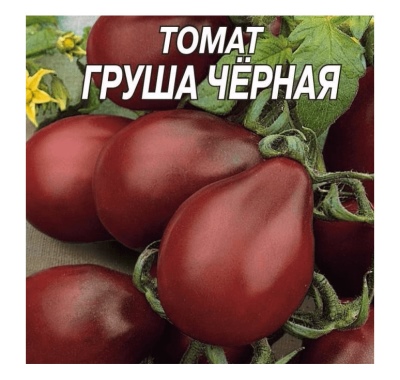
- Category: grade
- Growth type: indeterminate
- Appointment: fresh consumption, for pickling and canning, for whole-fruit canning
- Ripening period: mid-season
- Ripening time, days: 110-115
- Growing conditions: for open ground, for film greenhouses, for greenhouses
- Bush size: tall
- Bush height, cm: up to 200
- Ripe fruit color: brown-burgundy
- Fruit shape: pear-shaped
Black pear is a tomato variety related to Red Pear and Pink Pear. This species can be grown in any region of Russia, both in a greenhouse and in the open field.
Description of the variety
This is a tall bush up to 200 cm high. 5-8 fruits are formed in the brush at once. There are few leaves, their color is light green.
The main qualities of the fruit
In mature form, pear tomatoes are black brown-burgundy, on average, the fruit weight is 50-80 g, the shape is pear-shaped. Tomatoes have a smooth skin and firm pulp, which explains the good keeping quality of the fruit.
Taste characteristics
The pulp contains many seed chambers, but the taste is sweet, almost without acid, in fact, the classic taste of good tomatoes. The fruits are suitable for fresh consumption, for whole fruit canning, however, keep in mind that the inside of the tomato contains a light green stem, which can be a hassle when preparing a fresh salad.
Ripening and fruiting
Black pear belongs to varieties with a mid-ripening period, the first tomatoes can be eaten after 110-115 days. Harvesting usually takes place in July-August.
Yield
This is a high-yielding variety that, subject to all the rules of agricultural technology, yields a yield of 5.0-5.6 kg / m2.
The timing of planting seedlings and planting in the ground
Seedlings are sown in late February - early March. Prepare the seeds in advance:
- eliminate damaged planting material;
- soak the grains in a saline solution;
- treat them with a solution of potassium permanganate for disinfection;
- treat with honey and water to stimulate germination.
Until the seeds germinate, leave them in a container under the plastic wrap. When the first shoots appear, open the film for a couple of hours every day, after a week remove it completely.
Seedling care consists of the following procedures.
- Water the young seedlings as the soil dries up, try not to get water on the greens.
- Move the container with the hatched sprouts to a sunny place.
- When the first leaves appear, dive the seedlings.
- Three times young shoots need to be fed with special seedlings. One bush requires half the portion indicated on the package.
- Two weeks before transplanting to the site, the sprouts should begin to undergo a hardening procedure. Take the container outside, increasing the time it is outdoors every day.
- In late April - early May, shoots can be transplanted to the site.

Growing tomato seedlings is an extremely important process, because it largely depends on whether the gardener can harvest at all. All aspects must be taken into account, from seedbed preparation to planting in the ground.
Landing scheme
The ridge for planting is prepared in the fall. During this period, the earth is dug up, weeds are removed, fertilizers are applied. In the spring, the site is dug up again and fed again with organic matter. The planting process consists of the following stages:
- dig holes 25 cm deep in a checkerboard pattern of 40x60 cm, up to 4 plants will be planted per 1 m2;
- add ash to the pits;
- place seedlings in the holes along with a clod of earth;
- water the planting site and cover with soil.

Growing and care
Tomatoes need regular watering and timely feeding. You need to fertilize the culture three times per season, while giving preference to mixtures containing phosphorus and potassium. But it is important not to overdo it with top dressing, otherwise the plant will devote all its strength to the formation of a green mass.
The culture responds well to loosening, hilling and mulching with straw. Stepchildren need to be removed regularly, it is customary to form a black pear bush into one stem. He is tied with twine to the supports.




A plant needs different micronutrients at each stage of growth. All fertilizers can be divided into two groups: mineral and organic. Folk remedies are often used: iodine, yeast, bird droppings, eggshells.
It is important to observe the rate and period of feeding. This also applies to folk remedies and organic fertilizers.
Disease and pest resistance
The presented variety is resistant to fruit cracking, but sometimes it can be affected by fungal infections. To avoid this, follow all the rules of agricultural technology, especially the irrigation regime, since fungi develop best in waterlogged and overdried soil. It will also be useful to treat the culture with "Fitosporin" or a solution of potassium permanganate twice a season.
As protection against pests, you can use an infusion of celandine, and a soap solution helps well against aphids.



























































































